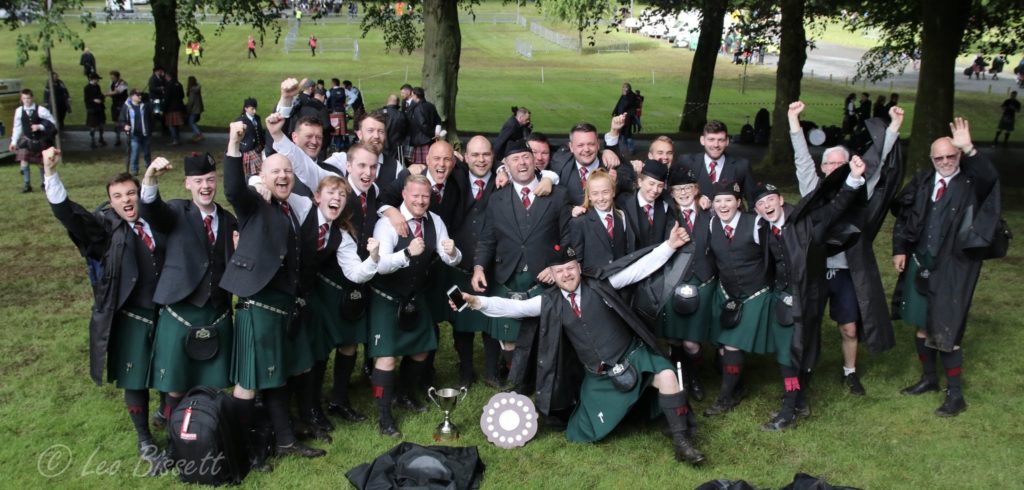
By Alistair Aitken OBE, former RSPBA adjudicator
Saturday 15 June saw the second of the RSPBA Major Championships of 2019 (the UK Championships) which this year took place in Lurgan, Northern Ireland. Most readers of Piping Press presumably will know that the UK Pipe Band Championships replaced in 2014 the Championships previously held in Dunoon as part of the famous Cowal Highland Gathering. For the last four years the event has been held in the grounds of Stormont in Belfast but this year a new home was found in Lurgan.
By my calculations a total of 94 bands competed at Lurgan compared to 118 at the first Major this year at Paisley. A significant number of Scottish bands did not enter for Lurgan, presumably due to the time commitment and the cost of travel and accommodation.
These losses were balanced to a large extent by more Northern Ireland and Republic of Ireland bands, many of which would not normally travel to Scotland for the same reasons. The same will happen the other way round to a greater extent at the third Major, the Europeans, being held in Inverness on Saturday (29 June), when there will be a much reduced representation from across the Irish Sea – three bands from Northern Ireland and one from the Republic.
[wds id=”2″]Nevertheless entries for Inverness number an impressive 120, although six of these are bands from Australia, one from Switzerland and one from the USA. What was particularly disappointing at Lurgan was that there were only three entries in Novice Juvenile B and six in Novice Juvenile A compared with 17 and eight respectively at Paisley, and 18 and nine respectively entered for Inverness).
These bands represent the foundation for the higher grade pipe bands of the future, so encouragement and support for their involvement at every opportunity is crucial. It is also worth pointing out that a total of 129 pipe bands competed at the last Cowal Championships in 2013, more than at either Paisley, Lurgan or Inverness. Dunoon with all its faults was a venue favoured by many pipe bands.
As already mentioned, adjudicator results will inevitably always be a matter of controversy. It was good to see that the number of wide differences between adjudicators was much reduced at Lurgan compared to Paisley, although not eliminated.
In Grade 1 St Laurence O’Toole continued their winning run, so congratulations again to P/M Alen Tully and L/D Steven Creighton. The remaining five placings saw a shuffle of the order from Paisley, with Field Marshal Montgomery rising from 5th to 2nd place. This opens things up making the three remaining Major Championships more exciting.

Closkelt continued its winning streak in Grade 2, as did St Mary’s Derrytrasna in Grade 3A, Dollar Academy in Juvenile and Lochgelly High School in Novice Juvenile B. In some grades many would argue that the results could have been skewed due to the absence of some potentially winning bands for the reasons already mentioned. Such arguments, however, would no doubt be ignored by the winning bands!
To conclude I would like to mention in particular the local competition held in Princes Street Gardens in Edinburgh on Sunday 23 June, which I was able to attend. Organised by the Lothian & Borders Branch the competition was in its third year, having been resurrected in Scotland’s capital city after featuring there regularly as a local contest until around year 2000.
[wds id=”9″]Princes Street Gardens of course was also the venue during the 1960s and 70s for the Scottish Pipe Band Championships now held in Dumbarton in July each year. Entries this year included two overseas bands – Haileybury from Australia and Mesa Caledonia from the USA.
What was again interesting this year was that all the bands (apart from Grade 1) performed in a semi-circle formation in front of the Ross Bandstand stage with the four adjudicators seated in front of them.
This type of competition formation was trialled by the RSPBA during the 1990s but was never implemented substantively as it attracted much criticism. The Grade 1 competition at Edinburgh, however, followed the traditional format of the bands marching into a circle, with the adjudicators adopting their favoured positions standing around the circle.

My own preference would have been to have all the adjudicators, for all the grades, positioned on the stage. I have had personal experience of this in the past and the stage is a great place to hear the band performances as the sound rises more collectively and you can hear everything very clearly as the bands are playing on what, in effect, is a concrete surface which projects the clarity of playing very well.
Apart from Grade 1 the adjudicators in their seated position were at least all hearing the same sound projection from each performance, which can vary depending on their chosen position when they are standing around the competing circle.

The Grade 1 competition involved Peoples Ford Boghall & Bathgate Caledonia, Glasgow Skye Association and Portlethen and District (playing up a grade). The results were in the same order.
The weather on the day was warm and sunny, which was ideal for the players. The event was warmly received by the spectators, proved by the large numbers listening and relaxing in the seated area in front of the bandstand.
I am sure the bands enjoyed performing in front of a large audience, many of whom would be tourists from across the world, and the general atmosphere also proved that there is a great deal of positivity about pipe band music. It was also good to see this competition continuing in one of Scotland’s iconic venues in the centre of the capital city.
- Read yesterday’s bulletin from Alistair here.















